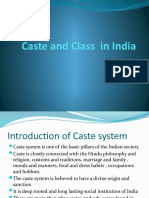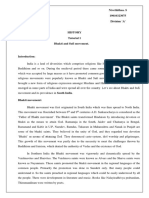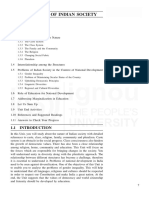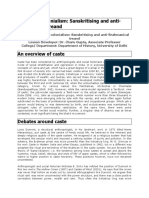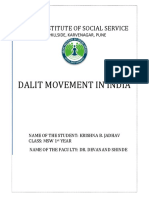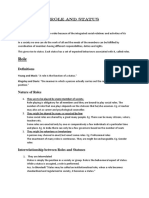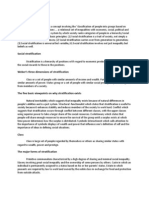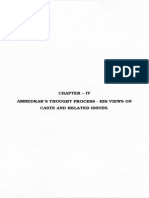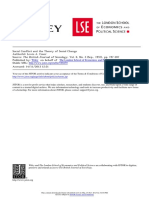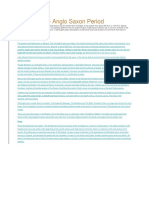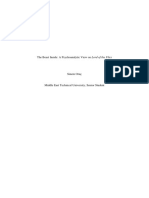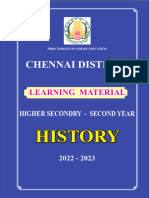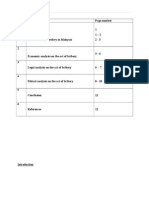Professional Documents
Culture Documents
Caste Class Gender and Ethnicity As Distinct Categories and Their Interconnection
Uploaded by
SakshiOriginal Title
Copyright
Available Formats
Share this document
Did you find this document useful?
Is this content inappropriate?
Report this DocumentCopyright:
Available Formats
Caste Class Gender and Ethnicity As Distinct Categories and Their Interconnection
Uploaded by
SakshiCopyright:
Available Formats
Caste, Class, Gender and Ethnicity as Distinct Categories and their
Interconnection
Paper: Human Rights, Gender and Environment
Lesson: Caste, Class, Gender and Ethnicity as Distinct Categories and
their Interconnection
Lesson Developer: Sanchita Ray
College/ Department: Department of Political Science, University of
Delhi
Institute of Lifelong Learning, University of Delhi
Caste, Class, Gender and Ethnicity as Distinct Categories and their
Interconnection
Contents
Introduction
Caste - features of caste system, effects of caste system, anti caste movement
Class- different classes in Indian society, middle class, Other Backward class
Gender different waves of feminism, variants of feminism, Indian feminism
Ethnicity – various problems related to ethnicity
Conclusion
Bibliography
Institute of Lifelong Learning, University of Delhi
Caste, Class, Gender and Ethnicity as Distinct Categories and their
Interconnection
Introduction
Human society has undergone tremendous transformation since its evolution. In the
process it has been greatly affected and influenced by several factors which imparted it
an extreme diversity. The diversity emerged in the form of caste, class, religion,
language, ethnicity etc. has greatly affected people political and cultural orientations and
also significantly affected levels of developmental process of human society. Thus, it has
become important to understand the concept like caste, gender, ethnicity and class in
order to understand the forces that shape and determine the human society. The notions
of caste, gender, ethnicity and class cannot be understood properly without having in
depth understanding of the mutual interactions and inter connectedness of these
concepts. For instance, in order to understand the status and position of women in
society one has to understand the caste system because high caste women do not enjoy
the liberties that low caste women have for example going to market to sell
commodities, working in the fields along with men and so on so forth . At the same time
lower caste women come under undue criticism inter alia entangled with different issues
like humiliation, atrocities at the hands of higher castes, denial of education and various
other basic rights as well. Thus, one can see how caste and gender are interlinked in the
Indian condition and it is essential to understand mutual relation to get a clear picture.
Thus this lesson tries to provide a broad analysis of the major social structures –
caste, class, gender and ethnicity and their mutual interactions and
interconnectedness.
Caste
Every civilization whether it is ancient, medieval or modern restructures its society in a
particular pattern. In each civilization stratified society appeared in one form or the other
for example masters and slaves, feudal lords and serfs, capitalists and proletariats etc.
Thus it cannot be denied that the possibility of absence of any stratification in any
society is almost absent. Societies are stratified on the basis of caste, class, status,
income groups etc. In India one can find social stratification in the form of caste which is
based on the birth of the individual in a particular family belonging to a particular caste .
The word "Caste" originates from the Spanish word 'Casta' which means 'breed, race,or
kind.' The Portuguese used this word to refer the different classes of people in India who
are also known by the name of 'jati'. The English word 'Caste' is an adjustment of the
original term 'Casta’.
In Indian context, the first literary traces of the caste system could be found in Rigveda
and Pursasukta hymn. Bhagavad Gita, the sacred hindu religious scripture, justified the
Institute of Lifelong Learning, University of Delhi
Caste, Class, Gender and Ethnicity as Distinct Categories and their
Interconnection
caste system on the basis of the idea of Guna Karma (deed/actions) and Dharma
(Religion). During the age of Simritis and Sutras, the Indian society had been divided
into various castes. Strict principles regarding occupation, food conduct and marriage
were framed. These castes became so diversified that they could not meet together in
course of time. The feeling of untouchability also sprouted which led to emergence of
higher caste and lower caste leading to exploitation and suppression of lower caste by
the higher. The term caste is used interchangeably with other terms like such as Varna,
Jati, biradri and samaj. However these terms are entirely different from each other.
The caste has been defined by various scholars in various ways. According to
Risley“caste is a collection of families or groups of families bearing a common name;
claiming a common descent from a mythical ancestor; human or divine professing to
follow the same hereditary calling; and regarded by those who are competent to give
opinion of forming a single homogenous community. The name generally denotes or is
associated with a specific occupation. A caste is almost invariable endogamous in the
sense that a member of the large circle denoted by a common name may not marry
outside that circle, but within the circle there are usually a number of smaller circles
each of which is endogamous” 1.
M.N. Srinivas defined “caste as an hereditary endogamous, usually localised group
having a traditional association with an occupation and a particular position in the local
hierarchy of castes. Relations between castes are governed among other things by
concepts of pollution and purity and generally maximum commensality occurs within the
caste.” 2
Ketkar defines a caste as ' a social group having two characteristics (i) membership is
confined to those who are born of members and includes all persons so born (ii) the
members are forbidden by an inexorable social law to marry outside the group. 3
According to Beteille, “caste is a small and named group of persons characterized by
endogamy, hereditary membership, and a specific style of life which sometimes includes
the pursuit by tradition of a particular occupation and is usually associated with a more
or less distinct ritual status in a hierarchical system” 4.
In Indian society, based on ritual purity each caste is given higher or lower rank in the
caste hierarchy. An important but peculiar feature of caste system is that there exist
some sort of relation between economic prosperity and ritual rank in caste hierarchy. It
has been observed that people belonging to higher castes tend to be more prosperous as
1
N. Jayapalan Rural Sociology Atlantic Publishers andDistributers, New Delhi, 2002, pp-133
2
M. N. Srinivas, Caste in Modern India and Other Essays, Asia Publishing House, Bombay,1962, p. 88.
3
N. Jayapalan ,ibid
4
André Béteille, Caste, Class, and Power: Changing Patterns of Stratification in a Tanjore, University Of
California Press ,1965, Pg-46
Institute of Lifelong Learning, University of Delhi
Caste, Class, Gender and Ethnicity as Distinct Categories and their
Interconnection
compared to members of lower castes as higher castes are allowed to pursue those
occupation that are essential and more profitable whereas as lower castes are allotted
demeaning jobs like scavenging, butchering, leatherworkers etc which are also low paid
jobs. As a result, people belonging to low caste live in abject poverty, misery and face
many hardships.
In India from birth to death it is the caste which dominates every sphere of one’s life
whether social, economic, political or religious. While interpreting the Indian society
caste becomes an important element which cannot be neglected. This caste system
cannot be found in other part of the world though there exist some social and racial
differences in one or the other form in other parts of the world, but the caste system in
India is unique one. The uniqueness lies in the features of caste system like the ritual
purity, the concept of pollution, complexity of castes, elaboration and rigidity.
Various feature of caste system:
1) Importance of hereditary and birth—caste system is based on two important
element – birth and hereditary. When a child is born immediately the caste of his
father becomes his caste with which he lives and dies so by birth a child gets his
caste. Caste is hereditary. From birth a child carries his father’s caste and as he
grows up, marries and has his own progeny, the progeny carries the same caste as
that of his father. The caste status never changes.
2) While in case of female before marriage her father’s caste becomes her caste and
after marriage her husband’s caste becomes her caste. Caste status of a female may
change if there is an inter caste marriage, which is against endogamy (another
feature of caste system).
3) Role of rigidity and immobility – Caste is rigid and immobile i.e if one is born into
a caste he cannot change it nor can he move up and down the status ladder. Hence it
is immobile.
3. Restrictions on social interaction and feeding:-Numerous restrictions were put
on lower castes in matter related to residence, marriage, eating habit, social interaction
etc. The theory of pollution is an innovation of caste system. Under this theory for
instance, simple touch or shadow of any Shudra defiles or pollute higher caste or
accepting water from the hand of Shudra would pollute the higher caste. Thus one
could say that the existence of Shudras was worse than that of animals.
Upper caste like Brahmins were not allowed to eat meat of any kind. Kshatriyas and
Vaishyas were prohibited from eating beef. There were no severe restrictions on Shudras
regarding food and drink.
Institute of Lifelong Learning, University of Delhi
Caste, Class, Gender and Ethnicity as Distinct Categories and their
Interconnection
4.Endogamy - an essential element- In Hindu society members of one particular caste
can marry within their caste or sub-caste. A person is not allowed to marry outside their
caste.
5.Lack of unrestricted choice of occupation:- Occupations of castes are fixed. The
higher castes like Brahmin, Khsatriyas and Vaisyas are entrusted with occupation like
priestly duties, protection of country and trade and agriculture where as lower castes
were given only the menial jobs and are not allowed to change to other occupation of
their choice. In caste system a person is allowed to do only that occupation which is
allotted to him by his caste. He cannot change his occupation to a better one, this
absence of upward social mobility obstruct one from achieving higher status
economically and socially.
6. Several civil and religious disabilities:-Lower castes are not allowed to perform
certain ceremonies for example upnayana i.e wearing of sacred thread. They were
also not allowed to enter temple nor had right to get education in schools and
colleges. The upper castes were considered as pure and touch of lower casts could
pollute them, this belief restricted the movement of lower caste people. In case a
Brahmin is accidently touched by lower caste he had to perform certain rites to get
purified.
7) Caste Panchayats--Every caste has its own panchayat to resolve disputes, crimes
and evils. The panchayats have the power to impose fine/penalty on its own member
depending upon the offense he committed. It functions as court.
Effects of caste system : Caste system led to untouchability which gave birth to
various type of exploitation and suppression of those belonging to lower castes. Caste
system is a major hindrance for economic and social development. It deprives a person
from doing an occupation of his choice. It is an impediment in the path of national unity,
solidarity and brotherhood because it separates one class from another thus denying any
type of social intercourse between them. It is undemocratic because it does not give
equal rights and opportunities to all. It creates false prestige among higher caste and
makes them to believe that they are better in every sphere than other castes and have
monopoly of wisdom. The caste system undermines the ability as well as aspirations of
people. It has also lead to religious conversion. People belonging to lower castes out of
frustration are embracing new faith.
Institute of Lifelong Learning, University of Delhi
Caste, Class, Gender and Ethnicity as Distinct Categories and their
Interconnection
Anti caste movement
The anti caste movement emerged out of the exploitation and domination of lower
castes by higher caste. In course of time the movement in order to eradicate the
system began taking shape in various parts of the country at various times.
Buddhism attacked the monopoly of the Brahmans in respect of sacred knowledge and
placed the Kshatriyas first in the hierarchy of the caste system, replacing the Brahmins.
His dethroning of Brahmans from their centuries old social status and replacing
kshatriyas on the top of caste system shows Budhdha’s protest against the hierarchal
system and reflects his radical thinking.
The rise of devotional movements both among the Vaishnavite and Saivaite sects could
be looked upon as protest movements against the paths of knowledge and action which
were the monopoly of certain sections of the Brahmans. The masses were deprived of
these paths which had become highly specialized and closed. The devotional
movements upheld the path of devotion which could be followed by all, irrespective of
caste and sectarian differences. They also replaced Sanskrit by the vernacular
languages, and this led to a significant development of devotional literature in different
regional languages. Protest movements in pre-British India were largely characterized
by their concern with religious beliefs and practices, as those constituted the chief area
of relative deprivation. Brahminical Hinduism had established a monopoly over paths of
salvation and denied the common man access to them. An awareness of the
deprivation grew in different degrees among various sections including the Brahmans
and the untouchables. The path of devotion provided the double-edged category of
establishing equality of all men in relation God on the one hand and attacking the
monopoly and supremacy of certain sections of Brahmans over Vedic knowledge and
action, as the source of salvation, on the other. In so far as the devotional movements
abrogated the criterion of birth, they brought about a significant change in the
principles of purity and pollution underlying the caste system. The English educational
system, along with its legal and administrative system all encouraged the spread of the
secular egalitarian ideology. The National Movement buttressed these ideas and helped
the Scheduled Castes to fight for their basic rights in the diverse areas of social life.
The lower caste movements that arose in the late nineteenth and early twentieth
centuries in different parts of colonial India had some identical themes like claim to
higher varna status, facilities in education, removal of social disability, reservation in
governmental services etc. Under British rule caste consciousness was enhanced and
almost every caste across India developed its own identity. In Maharashtra
Dr.Ambedkar developed an autonomous movement from 1920’s. He demanded
Institute of Lifelong Learning, University of Delhi
Caste, Class, Gender and Ethnicity as Distinct Categories and their
Interconnection
separate representation, the right to use tanks and enter temple. E.V Ramaswamy
Naicker founded Self Respect Movement. He advocated wedding without Brahmin
Priest, forcible temple entry, burning of Manusmriti. Swami Dayanand Saraswati
started Arya Samaj movement in Punjab for the dalits. It included them in its fold and
condemned untouchability. AdiDravid and Adi Andhra Movement had spread in South
India. These movements portrayed dalit as the indigenous people. The organization
like Andhra Mahajan Sabha and DravidMahajan Sabha were formed for undertaking the
programmes for dalitupliftment. In Bengal Namasudra Movement emerged against the
domination of upper caste.
B.R Ambedkar
Erode Venkata Ramasamy
He campaigned against social
Affectionately called by his discrimination
followers as Periyar or E. V. R. gainst Untouchables (Dalits),
He started the Self-Respect women and labour. He led a
Movement or the Dravidian satyagraha in Mahad to fight for
Movement. Periyar and his the right of the untouchable
followers campaigned community to draw water from the
constantly to influence and main water tank of the town.
pressure the government to Ambedkar publicly condemned the
take measures to remove social classic Hindu text, the Manusmrti
inequality.Source- (Laws of Manu). He wrote who
https://en.wikipedia.org/wiki/P were shudras?, Annihilation of
eriyar_E._V._Ramasamy,access Caste etc. Source-
ed at 9.10 pm on 11.08.15 https://en.wikipedia.org/wiki/B._R.
_Ambedkar, accessed at 9.09pm on
11.08.15
The old use of the term ‘caste’ somewhat changed in present day society. Some believe
that the Caste prejudices have lessened and caste sanctions do not operate with the
same force in all sections of Indian society due to widespread education, modern
outlook and emergence of new values brought by globalisation. But in the realm of
marriage caste still plays a important role. Endogamy is still the dominant mode in
contemporary Indian society but inter-caste marriages are becoming popular now days
Institute of Lifelong Learning, University of Delhi
Caste, Class, Gender and Ethnicity as Distinct Categories and their
Interconnection
among some sections of Indian society residing in urban areas. The ritual injunctions
and interdictions relating to food and physical contact have almost vanished.
At present caste has become a potential weapon for political leaders to gain support
during election and stay in power. The relation between caste and occupation has
become a thing of the past giving way to upward social mobility. Many new occupations
are being created wherein the members of all castes including Harijans (SCs) freely
meet and mix. The industrialisation opened the doors to an ever widening range of
choice and change of occupation. Social mobility became very easy.
Since India attained independence, the caste system has undergone great
modifications. Untouchability, the most undesirable feature of caste system has
received a some setback. It is disappearing though it still lingers in some belts and it
will take some time to completely disappear. Not only the temples have been thrown
open to the hitherto untouchables but also some Harijans are performing rituals in
temples as priests. Wells in the villages can be used by all. Public places are open for
all including untouchables.
Once, the caste panchayat used to wield all authority and Brahmins, in particular,
enjoyed a position of supremacy. But now such caste panchyats have lost their
authority. Other institutions such as village panchayats, trade unions, chamber of
commerce and State are now the exclusive arbiters in their respective fields and the
unchallenged position of Brahman, whose presence and blessings were required at
every activity has vanished except among orthodox thinkers.
The Constitution of India inserted many articles for the for the upliftment and progress
of Scheduled Castes, Scheduled Tribes. Constitution provides for reservation of seats in
Legislative Assemblies of the States under article 332 and the reservation of seats for
Scheduled Castes and Scheduled Tribes in the House of the People under article 330.
Similarly, reservations for Scheduled Castes and Scheduled Tribes have been provided
in local bodies also. Under article 335, the Constitution of India provided reservation to
services and posts for Scheduled Castes and Scheduled Tribes. Article 46 of the Indian
Constitution directs the government to promote educational and economic interests of
Scheduled Castes, Scheduled Tribes and other weaker sections. The Government has
provided reservation of seats in educational institutes for Scheduled Castes and
Scheduled Tribes and weaker sections to eradicate the difference between sections of
the people. Article 338 of the Constitution of India provides for the appointment of the
National Commission for Scheduled Castes and Scheduled Tribes to redress their
grievances. The commission submits its annual report to the Parliament.
Institute of Lifelong Learning, University of Delhi
Caste, Class, Gender and Ethnicity as Distinct Categories and their
Interconnection
Caste is based on a ritualised purity where places brahmins are placed on top and
lower caste are placed at the bottom of social hierarchy whereas class is based on
economic status, here rich ( landlord,merchants, businessmen etc) are at the top and
poor people (for example landless labour) are at the bottom.
Class
Class refers to a status group in a society. Here status indicate economic prosperity.
Thus Class is a person’s economic position in a society. If an individual is having good
education, receiving handsome salary, owns palatial house and vehicle of a particular
brand is regarded as an elite class where as a person who has no land of his own, no
earning source nor owns any vehicle is regarded as lower class. Thus the economic
prosperity defines a person’s class. The word Class has been defined in numerous
ways— For Sociologist class is one of the fundamental type social stratification.
Individuals are grouped into classes according to their economic positions and similar
political interest with in the stratification. Most societies have their own notion of social
class.
Marx defined class in term of social group having control over the means of production.
According to Marx society consisted of two classes capitalist or bourgeois class (those
who own means of production) and proletariat class ( those who don’t own means of
production or the labour class). In Max Weber’s opinion class is not merely a product
of the economic relations in society there are other factors that influences class like
‘status’ (the differences between social groups in the social honour or prestige) and
‘party’(a group of individuals who work together due to the fact that they have common
backgrounds, aims or interests) in society.
In societies where classes exist ,a single class is determined by few factors like
occupation, education, income ,wealth family background etc. According to VM
Dandekar, there are five major classes in India 1)Pre Capitalist(cultivator,agricultural
labour,and household industry) (2) Independent workers in capitalist society
(3)Employers (4) white collar employees (5) blue collar works. The main classes in India
today can also be referred to as (1) the agrarian classes (2) the industrial classes (3) the
professional classes and (5) the business and mercantile classes. Marx has talked about
class antagonism but class harmony and multiplicity of classes between haves and the
have-nots are other important factors that cannot be ignored. The existence of middle
class has not attracted the attention of Marx 5.
5
Pravin Kumar Jha, Indian Politics in Comparative Perspective,Pearson, New Delhi, 2011 pg- 122
Institute of Lifelong Learning, University of Delhi
Caste, Class, Gender and Ethnicity as Distinct Categories and their
Interconnection
The rapid growth of Indian economy in the last few decades contributed to a large
expansion of India’s middle class. The middle class refers to a large group who are
neither rich nor poor but having internal diversities in the form of occupation, income,
caste, community and region. This middle class played an important role in providing
leadership to various sections of the Indian society. The traditional leadership had been
displaced by these middle class. This middle class forms a large consumer base for the
market-based economy. Some important features of Indian middle classes are ---- they
are globally mobile, dwell in urban places , use the language of modernity and are active
participate in the articulations of identity politics of both the dominant “majorities” and of
the “minorities”. Unlike the Western context, the Indian middle class lacks autonomy. It
remains dependent on patronage and perpetuates the patronage culture 6.
Besides the middle class, OBC or Other backward classes play another important role in
political realm. Originally the word ‘Backward Classes’ was used around 1919 to refer to
a section of population which was backward in socio- economic sense. The term did not
limit itself to the matrix of caste, it encompassed the Depressed Classes, the aboriginal
tribes as well as the other backward classes. The Constitution of India does not clearly
defines OBCs. It only refers to "socially and educationally backward classes". For their
upliftment Constitution has taken several steps. Under Article 340 of the Indian
Constitution, it is obligatory on the part of government to promote the welfare of the
OBCs. In 1953, the Backward Class Commission was appointed. Kaka Kalelkar became
its Chairman. The Commission was given the task of determining the criteria that was to
be adopted for providing concessions to “socially and educationally backward classes”.
The Commission was also asked to prepare a list of such socially and educationally
backward classes. The Commission prepared a list of about 2400 castes.
Since the late 1980s, there was decline of upper-caste representation in the Lok Sabha,
and on the other hand there was simultaneous rise of OBCs. This scenario emerged due
to the decline of the Congress — a party dominated by upper castes — and to the rise of
regional parties, primarily supported by large, dominant OBC groups 7. OBCs, since early
1990’s occupied the centre of the political space in northern India.
6
http://www.kas.de/wf/doc/kas_29624-544-2-30.pdf?111205131841, also see article ‘Being middle
class in India’ by Devesh Kapur and Milan Vaishnav, published in The Hindu, December 9,2014
7
http://indianexpress.com/article/opinion/columns/the-representation-gap -/#sthash.Uorwom7f.dpuf
Institute of Lifelong Learning, University of Delhi
Caste, Class, Gender and Ethnicity as Distinct Categories and their
Interconnection
The recommendation of Mandal Commission for reservation of 27 per cent Government
jobs for backward classes, not only drew reactions in its support or against it, it also
changed the contours of Indian politics. Honorable Supreme Court passed an order
according to which the creamy layer has to be excluded from reservation. Thus Other
Backward Classes play a very important role in India’s political arena.
The Supreme Court of India, on 29 March 2007, placed a stay on the law providing for
27 percent reservation for Other Backward Classes in educational institutions like IITs
and IIMs. This was done in response to a public interest litigation. In 2008, the Supreme
Court of India upheld the government's initiative of 27% OBC quotas in government-
funded institutions. In March 2015, Supreme Court of India declared that Jats are not
socially and economically backward in reference with National Commission for Backward
Classes' (NCBC) and scrapped Jat Reservations . Supreme Court judgement quashed
the proposed inclusion of Jats in Central list of OBCs 8.
However it is to be noted that the list of OBCs include groups from different religious
communities. Unlike reservation for SCs that include lower castes and Hindu community
Sikhs and Buddhist, the list of OBCs at center as well as at state include some Muslim
and Christian communities. The weaker section among these communities have been
demanding reservation and the quota for OBCs has allowed political parties some space
to accommodate them. Apart this, the quota of reserved seats for OBCs also differs from
state to state. Even within the state the criteria and the list of beneficiaries has been
continuously revised and changed. The criteria used for inclusion and exclusion in the list
also varies both within a state and across state, thus there is practice of a complex
scheme where some communities are beneficiaries in one state but if they move to the
9
neighbouring state they may not be in the list of beneficiaries.
Ethnicity
In the social sciences, “ethnicity” has emerged as an important analytical category. The
various dimensions of ethnicity have been continuously engaging the attention of
scholars in different disciplines like anthropology, economics, political science and
sociology. The salience of ethnicity in the social sciences is explained by the rising trend
of ethnic movements, ethnic mobilisation, ethnic conflict and ethnic insurgency around
the world.
The word ‘ethnic’ is derived from Greek word ‘ethno’ which means nation. The term
ethnic group denote a social group that shares a common and distinctive culture,
religion, race, language, customs, beliefs where as ethnicity refers to the inter
8
https://en.wikipedia.org/wiki/Other_Backward_Class
9
Atul Kohli, Prerna Singh ,Routledge Handbook of Indian Politics,New York, 2013, p 148-49
Institute of Lifelong Learning, University of Delhi
Caste, Class, Gender and Ethnicity as Distinct Categories and their
Interconnection
relationship between ethnic groups. The ethnic phenomenon whether defined in terms
of common ancestry, culture, experience or even region gives rise to spirit de corps
among the members of a group which lends it a distinct identity. These identities are
expressed and maintained by a name, shared beliefs and symbols and projection of a
distinct life style. Ethnic identity, besides providing an individual or a group a requisite
base for interaction through identification differentiates individual or groups outside its
purview. The identity of an ethnic group or its member is not just a case of self identity
but an identity which others concede vis a vis their own. 10 According to Punekar 11 the
four major premises where ethnicity operates are language, region, religion and caste.
In India religion is an important form of ethnic identification. Here several religions are
practiced Hinduism, Islam, Sikhism, Christianity, Buddhism etc. The assertion of these
religion based ethnic identities led to eruption of violent communal riots in several parts
of the county .After religion, linguistic aspirations of the people emerge as a major
challenge that threatens the unity and integrity of the nation. After independence, there
emerged strong demand for the creation of linguistic states, as a result, the government
appointed the States Reorganization Commission which recommended the creation of
linguistic states. Various states were reorganized on the linguistic basis throughout
India. Language played a significant role in the division of Punjab in 1966 and the
secessionist movement of Punjab was constructed on the perception of threats to Sikh
religion and culture. Another aspect of the linguistic problem is related to the opposition
to Hindi languages by the southern states, particularly Tamil Nadu. With the introduction
of the tri language formula which consists of Hindi, English and one’s own vernacular
language, the linguistic problem has been solved. The region based ethnic aspirations of
the people has led to emergence of several movements based on the demand for
separate state. The main reason for emergence of such movements is the issue of
underdevelopment of a particular region as compared to the areas surrounding the
region. With the creation of the states like Uttaranchal, Chhatisgarh and Jharkhand,
efforts were made by the Central government to reduce the feeling of regional identity.
However serious efforts must be made to harmonize regional aspiration with unity and
integrity.
In India, caste acts as some sort of ethnic identity of the people has been commonly
experienced. The role of caste has changed in post independent India because of
politicization of caste as well as its de ritualization. In contemporary India caste remains
a viable ethnic category --- kinship based ethnic category for mobilizing people in
electoral politics. Electoral politics, reservation politics etc show how caste plays an
important role in Indian society.
10
Chandrashekhar Bhat, Ethnicity and Mobility , Concept Publishing Company, New Delhi, 1984 pp-22
11
ibid
Institute of Lifelong Learning, University of Delhi
Caste, Class, Gender and Ethnicity as Distinct Categories and their
Interconnection
India has more than two thousand ethnic groups. The modern Indian
republic is home to 97% of Jains, 90% of Sikhs, 87% of Hindus, 50%
of Zoroastrians, 40% of Baha'i, 20% of Shia, 10% of Muslims, 5% of
Ahmadiyya, 2% of Buddhists and 1% of Christians worldwide.
Source--https://en.wikipedia.org/wiki/Demographics_of_India,
accessed on 11.08.15 at 6.30pm
Gender
The term gender is used to refer to the socially constructed differences between
men and women. It prescribes specific roles for them and accordingly defines the status
of women and men in the family and in society. Gender prescribes what a man should
do and a woman should not and what a woman should do and man should not etc.
Despite the fact that sex and gender are used quite often synonymously they are not the
same. The term sex is a biological category where as gender is socially constructed
feminine and masculine patterns of behaviour for women and men.
Gender based social roles defines the nature and type of functions taken up by
women and men. In most societies activies of women are limited to looking after home
and family. They are not allowed to participate in activities that go beyond the roles that
are confined to family. They are deprived of proper education and job opportunities.
Thus making them dependent on men for example father, brother or husband for
financial support. This led to controlling of women by men. This controlling of women by
men leads to domination, exploitation and suppression of women by men. Thus giving
rise to Gender inequality. In principle men and women both are same having similar
talent, mental faculty, possessing same rights and duties. But in reality it is just
opposite. In most societies women receives unequal treatment for instance they are
made to stay at home to do household chores, in terms of ownership of property such
as land or access to other resources such as food and health care women are thoroughly
discriminated, women are not given political power etc. All such discrimination has given
Institute of Lifelong Learning, University of Delhi
Caste, Class, Gender and Ethnicity as Distinct Categories and their
Interconnection
rise to movements focussing on women’s liberation .
The main focus of feminist movement is to highlight the social role of women.
The ideology of feminism centres around discrimination of women on the basis of her sex
without any logical basis. The division of work between male and female is deliberately
done by a male dominated society so as to perpetuate male domination over female.
Why?
Gender Inequality 1
The feminist movement could be understood by studying the different waves of
feminism. The first wave of feminism was associated with the equality of both sex in
education employment and voting rights. It emerged in 1840s and 1850s. The First wave
feminism believed that attaining franchise rights will lead to removal of all sorts of
discrimination and prejudices against women. Equal legal and political rights were
demanded by first wave feminism. Thus by early twentieth century most of the western
countries achieved female suffrage. In New Zealand women suffrage was first
guaranteed in 1893, US Constitution guaranteed voting rights to US women in 1920.
Mary Wollstonecraft
Wollstonecraft is regarded as one of the founding feminist
philosophers. She wrote A Vindication of the Rights of
Woman (1792). in which she argues that women are not naturally
inferior to men, but appear to be only because they lack education. She
suggests that both men and women should be treated as rational
beings and imagines a social order founded on reason. Source-
https://en.wikipedia.org/wiki/Mary_Wollstonecraft, accessed at 8.10pm
on 11.08.15.
Institute of Lifelong Learning, University of Delhi
Caste, Class, Gender and Ethnicity as Distinct Categories and their
Interconnection
The second wave of feminism arose during 1960s which focused on a number of
issues such as different identity of women and the question of public private domain. It
was during this wave of feminism that the slogan ‘personal is political’ was given. The
liberal theory at this point of time was busy in protecting privacy of human beings. The
argument was that the state should not intervene in the domestic life of a person which
would be regarded as violation of one’s privacy. The second wave feminism challenged
this public private demarcation by arguing that in domestic sphere (personal) women are
exploited the most so to stop such exploitation state had every right to intervene in
personal sphere. Second wave came up with works of Shulamith Firestone “ The Dialectic
of Sex”(1970), Germaine Greer “the female Enuch”(1970), Kate Millet “the Sexual
Politics”(1970), Eva Figes “Patriarchal Attitudes”(1970) etc.
Shulamith Firestone .
She was a central figure in the early development of radical
feminism. She authored “ The Dialectic of Sex: The Case for
Feminist Revolution”.
Source- https://en.wikipedia.org/wiki/Shulamith_Firestone
accessed on 7.55pm on 11.08.2015
Third wave of Feminism developed after 1990’sand is still going on. Third wave
feminism is proof of the success of second wave feminism to a larger extent. In 1980’s
as would be evident from Thatcher and Reagan administration which were openly anti
feminist in their call for restoration of family values.there were also other voices
emphasising on women’s traditional role is a guarantee of social order and stability.
Some even went to the extent of blaming working mothers for rise in crime and
vandalism. This is what Susan Faludi referred in Blacklash (1991)as the ‘blame ti on
feminism syndrome’. Camillie Paglia (1990) attacked the image of women as ‘victims’.
She insisted on the need for women to take greater responsibility for their own sexual
Institute of Lifelong Learning, University of Delhi
Caste, Class, Gender and Ethnicity as Distinct Categories and their
Interconnection
and personal conduct. In this phase specific contribution have been made in the field
of definition of feminity, question of female identity and sexuality etc. In this phase
gender binary has been rejected and issues such as eco feminism, trans nationalism and
trans gender identity and politics have also been raised.
Rebecca Walker
The term "third-wave feminism" was
used for the first time by Rebecca
Walker in 1992 in an essay "Becoming
the Third Wave". Source-
https://en.wikipedia.org/wiki/Rebecca
W lk A d 11 08 15 t
Various variants of feminism
Liberal feminism- it stands for equality of treatment of men and women in
education, employment and equal right to franchise. It also makes a strong argument
against discrimination of women in patriarchal set up. Liberal feminists were not for any
radical change or transformation rather they focussed on reforms to bring women on
equal footing. It was believed that spread of education among women and their equal
treatment in society, polity and economy would bring their exploitation to an end. Liberal
feminist were Mary Wollstonecraft , Betty Friedman.
Radical feminism have been able to make a forceful statement that women are
different with a distinct identity of their own which needs to be celebrated and respected.
They see masculinity as aggression & violence by men against women and males are
regarded as the problem rather than the solution.
Socialist feminism – The central focus of socialist feminism is on understanding
Institute of Lifelong Learning, University of Delhi
Caste, Class, Gender and Ethnicity as Distinct Categories and their
Interconnection
patriarchy by linking it with social and economic factor. According to them it is the social
and economic structure which is at the root of male female relationship. As a solution
they suggest abolition of both class as well as gender.
The scholars belonging to Black feminist group argue that sexism, class
oppression and racism are inter-related. They express a new hope that liberation of
black women will lead to liberation and freedom for all people. Post modern and post
structuralist feminists argue that there is no single cause for women’s subordination.
Thus there cannot be any single approach to deal with the issue. Post modern and post
structuralist feminist believe in essential differences between men and women. Eco
feminism is a new form in post modern time which finds a lot of similarity between
nature and women. The traditional female values such as reciprocity, nurturing and
cooperation are common both to women as well as nature. According to the eco feminist,
the nature has also suffered the same kind of on slaught because of masculine drives.
Pandita Ramabai
Raja Ram Mohan Roy
Founder of Brahmo samaj also referred as “ Pandita Ramabai was an Indian social
The Father of Indian Renaissance” reformer, a champion for the emancipation
Rammohan Roy put all his effort to abolish of women, and acquired a reputation as a
the practice of Sati. Sanskrit scholar. In 1889 she had started a
home-cum-school in Bombay, which she
Source-
named as Sharda Sadan. This was the first
https://www.google.co.in/search?q=ram+mo
han+roy+wiki accesed on 11.08.15 at 8.20 home for widows in Maharashtra. She
pm received Kaisar-i-Hind medal for community
service in 1919 by the British Government.
Source-
https://en.wikipedia.org/wiki/Pandita_Rama
bai accessed on 11.08.15 at 7.30pm
Indian feminism
The history of feminism in India started when male reformist like Raja Ram Mohan Roy,
Ishwar Chandra Vidhyasagar, Keshab Chandra Sen begun talking against the social evils
Institute of Lifelong Learning, University of Delhi
Caste, Class, Gender and Ethnicity as Distinct Categories and their
Interconnection
of Sati, child marriage, widow remarriage, women education etc. Pandita Ramabai
dedicated her life for the upliftment of women and emancipation of women. Period from
1915 to Indian independence saw emergence of women when Gandhi incorporated
women's movements into the Quit India Movement and with these various independent
women's organizations began to form. The issues dealt by of these women movements
were education, removal of dowry, education for women etc. In post-independent era,
women movement mainly focused on fair treatment of women in the work force and
right to political parity. As a result many organization came into existence for instance
National Federation of Indian Women (NFIW) in 1954, formation of the Self Employed
Women’s Association (SEWA) in Ahmadabad. Apart these, dowry issues, domestic
violence, education, female foeticide, abortion etc were also raised by the women
movement. This period witnessed series of legislation for the upliftment of women for
instance-- The Hindu Marriage Act of 1955, The Hindu Adoption and Maintenance Act of
1956, the Hindu Minority and Guardianship Act of 195, The Hindu Succession Act of
1956, The Hindu Women Right to Property Act of 1973, The Dowry Prohibition Act of
1961, The Equal Remuneration Act of 1976, Domestic Violence Act 2005 etc.
Conclusion
The last decade of twentieth century and early years of twenty first century witnessed
some significant developments in India indicating intensification of political struggles
involving caste class gender and ethnic identity. The adoption of economic reform in
1991 invited a new stage of economic development in India, giving privilege to the
capitalist class to lead the process of economic development. The period witnessed
Various kinds of social conflicts many of whom were manipulated by the political parties
for electoral purpose ----- emergence of Backward classes(Mandal commission, problem
of jats reservation), resurfacing of Communal riots ( demolition of Babri Masjid,
Communal Carnage in Gujrat in 2002), women’s movement ( passing of domestic
violence act 2005, The Sexual Harassment of Women at Workplace ( Prevention,
Prohibition and Redressal) Act, 2013), separatist movement in J&K , ethnic conflicts etc.
Thus on one hand the economic development was speeding up on the other the country
was going through internal turmoil due to various movements and conflicts. The decision
by VP Singh government in 1990 to implement the Mandal commission report which
gave 27% reservation to backward classes in All India Public Service Commission led to
huge anti Mandal agitations. The decision was upheld by Supreme Court and many
political parties decided to enforce it and compete for electoral support. In 1980s the
women’s movement resulted in the institutional changes in 1990s –the 73rd Amendment
Act enacted in 1993 called for 1/3rd reservation for women in three tier Panchayati Raj
and the 74th Amendment Act resulted in 1/3rd reservation for women in urban bodies like
Corporations, Municipalities etc. Later on political parties like Rashtriya Janata Dal and
Institute of Lifelong Learning, University of Delhi
Caste, Class, Gender and Ethnicity as Distinct Categories and their
Interconnection
Samajwadi Party asked for reservation for backward class women. These developments
brought into focus an interconnection among various kinds of demands. Thus a link was
developed between caste,gender and class. The ethnicity became the another important
area to focus on along with caste , gender and class when in 1980s there was rise of
autonomous movements in various places of India demanding political safe guards for
ethnic identity. The Military spurt in Jammu and Kasmir and also in North East has
12
severe consequence on the polity as a whole.
With the emergence of various demands there was focus on the caste,gender,class and
ethnicity. On the basis of various observations made in the context of caste, class,
gender and ethnicity it may be concluded that there is an imperative need to understand
the age old social systems existing in India from its grass root level , its impact on the
socio – economic progress and politico cultural systems so that the perennial
persistence of disparity and forces that are responsible for dividing the society could be
eradicated. In this context it is necessary to investigate the underlying basic reasons for
economic disparity, social inequality unequal distribution of power, status and property
in terms of caste, class, gender and ethnicity in order to make a long cherish dream of
building an ideal society which is indispensible to emphasise the interconnectiveness of
various social forms like caste, class, gender and ethnicity apart from making them
visible as distinct categories to get a holistic image of Indian social reality in future.
12
Manoranjan Mohanty(ed), Caste Class Gender, Sage Publication , New Delhi,2004,p-13-15
Institute of Lifelong Learning, University of Delhi
Caste, Class, Gender and Ethnicity as Distinct Categories and their
Interconnection
Long Answer Type Questions
Q1. Critically evaluate the modern trends in Caste System
Q2. Write a brief note on ‘ Backward Classes and Affirmative Action’
Q3.Examine the status of women in contemporary India.
Q4.What is ethnicity? Discuss the various dimensions of the problems of ethnicity in
India.
Q5.Discuss different waves of Feminism.
Multiple Choice Questions
1.The National Commission for women was set up in the year _______.
A. 1992.
B. 1993.
C. 1994.
D. 1995.
Ans. A
2. Caste system is determined by ___
A. Socialization
B. Education
C. Economic affluence
D. Birth itself
Ans. D
3. Q3. Name any two political leaders who fought against caste inequalities.
(a) Dr.Manmohan Singh and Smt. Pratibha Devi Singh Patil.
(b) Mr.Nitesh Kumar and Mr.NarendraModi.
(c) Dr.S. Radhakrishnan and ShriMorarji Desai
(d) Mahatma Gandhi and Dr.B.R. Ambedkar
Ans. D
Q4When we speak of gender divisions, we usually refer to:
a. Biological difference between men and women
b. Unequal roles assigned by the society to men and wome
c. Unequal child sex ratio
d. Absence of voting rights for women in democracies
Institute of Lifelong Learning, University of Delhi
Caste, Class, Gender and Ethnicity as Distinct Categories and their
Interconnection
Q5Which among the following statements about India’s Constitution is wrong? It
a. Prohibits discrimination on grounds of religion.
b. Gives official status to one religion.
c. Provides to all individuals freedom to profess any religion.
d. Ensures equality of citizens within religious communities.
Q6.Which of the following gives more value to men and also give them power over
women
a) Patriarchy
b) Feminist
c) Radicalist
d) Socialist
Q7 An ethnic group is a category of people who are distinguished, by others or
themselves, on the basis of:
e) Their personalities
f) Their social system
g) Physical characteristics
h) Cultural or nationality characteristics
Q8. Which theories focus primarily on the experiences of women in society
i) Feminist theory
j) Functionalist theories
k) Marxist theories
l) All of the above
Q9 First wave of feminism focussed on
a) Franchise for women
b) Feminine behaviour
c) Class exploitation
d) Class politics
Q10. Race is _____________, while ethnicity is ______________.
a) Biological,cultural
Institute of Lifelong Learning, University of Delhi
Caste, Class, Gender and Ethnicity as Distinct Categories and their
Interconnection
b) Intrinsic , extrinsic
c) Objective , subjective
d) Mongoloid, caucasian
References
1. N. Jayapalan Rural Sociology Atlantic Publishers andDistributers, New Delhi,
2002
2. M. N. Srinivas, Caste in Modern India and Other Essays, Asia Publishing House,
Bombay,1962
3. André Béteille, Caste, Class, and Power: Changing Patterns of Stratification in a
Tanjore, University Of California Press ,1965
4. Pravin Kumar Jha, Indian Politics in Comparative Perspective,Pearson, New Delhi,
2011 pg- 122
5. Manoranjan Mohanty(ed), Caste Class Gender, Sage Publication , New
Delhi,2004
6. Atul Kohli, Prerna Singh ,Routledge Handbook of Indian Politics,New York, 2013,
p 148-49
7. Chandrashekhar Bhat, Ethnicity and Mobility , Concept Publishing Company, New
Delhi,
8. MP Singh ,Himanshu Roy (ed) Indian Political thought, Pearson, New Delhi, 2011
9. Andrew Heywood Political Ideologies :An Introduction, Palgrave MacMillan,2007
Websites visited
http://www.kas.de/wf/doc/kas_29624-544-2-30.pdf?111205131841
https://en.wikipedia.org/wiki/Pandita_Ramabai
https://en.wikipedia.org/wiki/Rebecca_Walkerhttps://en.wikipedia.org/wiki/Rebecca_Wal
ker
Institute of Lifelong Learning, University of Delhi
Caste, Class, Gender and Ethnicity as Distinct Categories and their
Interconnection
https://en.wikipedia.org/wiki/Shulamith_Firestone
https://en.wikipedia.org/wiki/Demographics_of_India
Institute of Lifelong Learning, University of Delhi
You might also like
- Caste System in IndiaDocument28 pagesCaste System in IndiaFor AmazonNo ratings yet
- Caste, Varna and JatiDocument7 pagesCaste, Varna and JatiSuman DasNo ratings yet
- SM1 - Lesson 1 To 15Document238 pagesSM1 - Lesson 1 To 15nksNo ratings yet
- Modernity and TraditionDocument11 pagesModernity and TraditionAbhiram Jain100% (2)
- Varna SystemDocument14 pagesVarna SystemlovleshrubyNo ratings yet
- Caste System 1Document9 pagesCaste System 1drarpitabasakNo ratings yet
- Sanskritisation, Westernisation, ModernisationDocument9 pagesSanskritisation, Westernisation, ModernisationRaja Sanmanbir Singh75% (16)
- M N SrinivasDocument5 pagesM N SrinivasSandeep Kumar Meena100% (1)
- Sanskritization: Meaning, Characteristics, Models and EffectsDocument4 pagesSanskritization: Meaning, Characteristics, Models and EffectsSamiksha PawarNo ratings yet
- PGSO S1 03 (Block 1) PDFDocument126 pagesPGSO S1 03 (Block 1) PDFआई सी एस इंस्टीट्यूटNo ratings yet
- Types of Social Stratification - 6 TypesDocument9 pagesTypes of Social Stratification - 6 TypesAnqa Parvez100% (1)
- Yogendra SinghDocument8 pagesYogendra SinghGARIMA VISHNOINo ratings yet
- PurusharthasDocument4 pagesPurusharthasMokshha Sharma100% (2)
- Sanskritisation Westernisation ModernisationDocument12 pagesSanskritisation Westernisation ModernisationMansi Agarwal100% (1)
- Iravati KarveDocument6 pagesIravati KarveNishat Singh100% (1)
- Sociology ProjectDocument17 pagesSociology ProjectSiddarth PrakashNo ratings yet
- Jajmani SystemDocument11 pagesJajmani SystemYash Tiwari100% (1)
- Women Movements in IndiaDocument13 pagesWomen Movements in IndiaSonali SharmaNo ratings yet
- Varna and Caste in Ancient IndiaDocument6 pagesVarna and Caste in Ancient IndiaParthesh PandeyNo ratings yet
- Caste System Compilation PDFDocument17 pagesCaste System Compilation PDFBond__001No ratings yet
- Bhakti and Sufi MovementDocument4 pagesBhakti and Sufi MovementNivethithaa100% (2)
- Social StratificationDocument20 pagesSocial StratificationMayank Aameria0% (1)
- Jajmani System in India: Meaning, Definition, Advantages and DisadvantagesDocument6 pagesJajmani System in India: Meaning, Definition, Advantages and DisadvantagesPritesh Kashyap100% (1)
- DR B.R. Ambedkar: Prospects of DemocracyDocument2 pagesDR B.R. Ambedkar: Prospects of DemocracyNilabhNo ratings yet
- Nature of Indian SocietyDocument16 pagesNature of Indian SocietyArya BNNo ratings yet
- Caste and Colonialism: Sanskritising and Anti-Brahmanical TreandDocument9 pagesCaste and Colonialism: Sanskritising and Anti-Brahmanical Treandzeba abbas100% (1)
- Sociology Notes Untouchability and Social MovementDocument26 pagesSociology Notes Untouchability and Social Movementbb2No ratings yet
- Unit 2.5 AmbedkarPhuleJidduDocument10 pagesUnit 2.5 AmbedkarPhuleJidduSaroja0% (2)
- Altekar'S Paradigm On Gender and Its Critique Title of The Subject: 1.2 HistoryDocument18 pagesAltekar'S Paradigm On Gender and Its Critique Title of The Subject: 1.2 HistoryAkhya100% (1)
- Features of Caste SystemDocument2 pagesFeatures of Caste Systemjyoti kunduNo ratings yet
- The Historical & Evolutionary Theory of The Origin of StateDocument5 pagesThe Historical & Evolutionary Theory of The Origin of StateMateen Ali100% (1)
- 5.1. Political Ideas of Shanti ParvaDocument11 pages5.1. Political Ideas of Shanti ParvaThangam pooja100% (1)
- Perspectives On Indian SociologyDocument27 pagesPerspectives On Indian SociologySoumyadip Chatterjee89% (9)
- Structural-Functionalist PerspectiveDocument4 pagesStructural-Functionalist PerspectiveAnirbaan AntareepNo ratings yet
- Sociology Mains: IGNOU BA, MA (No Registration), Topper Notes, Last 34 Years Question Papers (1979-2012), NCERT, NiosDocument43 pagesSociology Mains: IGNOU BA, MA (No Registration), Topper Notes, Last 34 Years Question Papers (1979-2012), NCERT, NiosKeshav Prasad75% (4)
- Sanskritization and WesternizationDocument16 pagesSanskritization and WesternizationAnuj RakkanchathNo ratings yet
- A 1 - Gs GhuryeDocument7 pagesA 1 - Gs GhuryeStalin NayakNo ratings yet
- 7 Comparative MethodDocument5 pages7 Comparative Methodvarun102767% (3)
- PDF Download Buddhist Theory of KingshipDocument9 pagesPDF Download Buddhist Theory of KingshipHimani RanaNo ratings yet
- Dalit Movement PDFDocument8 pagesDalit Movement PDFMohammadZaid AttarNo ratings yet
- Roles and Status Full NotesDocument4 pagesRoles and Status Full NotesArchana Patwal100% (1)
- Cast SystemDocument77 pagesCast SystemVishal KapoorNo ratings yet
- Indian Social ThoughtDocument19 pagesIndian Social ThoughtTahreem Gull60% (5)
- Social Movements in India: Growth of The Women's Movement in IndiaDocument10 pagesSocial Movements in India: Growth of The Women's Movement in IndiayoyoNo ratings yet
- Course Name-B.A.L.L.B.Ivth Sem Subject - Sociology Teacher - Dr. Niru Jain Topic - Sanskritization, Westernization, ModernizationDocument24 pagesCourse Name-B.A.L.L.B.Ivth Sem Subject - Sociology Teacher - Dr. Niru Jain Topic - Sanskritization, Westernization, ModernizationClark KennttNo ratings yet
- Caste and ClassDocument7 pagesCaste and ClassSuresh Murugan100% (5)
- Ambedkar Views PDFDocument87 pagesAmbedkar Views PDFShaifali gargNo ratings yet
- Post Mauryan Polities With Special Reference To The Kushanas and The SatavahanasDocument4 pagesPost Mauryan Polities With Special Reference To The Kushanas and The SatavahanasPinaki ChandraNo ratings yet
- Nationalist ApproachDocument6 pagesNationalist Approachlirza100% (1)
- Class SystemDocument7 pagesClass SystemdrarpitabasakNo ratings yet
- Rural and Urban SocietyDocument15 pagesRural and Urban Societyvijay chittiboyina100% (1)
- Research Proposal On Caste System DsmruDocument10 pagesResearch Proposal On Caste System Dsmrubb2100% (1)
- Patriarchy - Ignour Sociology CourseDocument64 pagesPatriarchy - Ignour Sociology CourseMd Ali MajorNo ratings yet
- BA Politics - VI Sem. Additional Course - New Social MovementsDocument59 pagesBA Politics - VI Sem. Additional Course - New Social MovementsAnil Naidu100% (2)
- Auguste Comte's "Law of The Three StagesDocument9 pagesAuguste Comte's "Law of The Three StagesKamrankhan KamranNo ratings yet
- Different Approaches To The Study of Indian History NDocument37 pagesDifferent Approaches To The Study of Indian History NAbhinav Jain100% (1)
- Caste and Indian Politics NotesDocument7 pagesCaste and Indian Politics Notesnosferatu jodNo ratings yet
- Womens Studies in IndiaDocument16 pagesWomens Studies in IndiaAnil PintoNo ratings yet
- Caste-Class and Rural-Urban DivideDocument6 pagesCaste-Class and Rural-Urban DivideSanchita GhoshNo ratings yet
- Caste SystemDocument4 pagesCaste SystemAnwar Ali TanhaNo ratings yet
- A2AS ELIT REVISED Support 8927 PDFDocument10 pagesA2AS ELIT REVISED Support 8927 PDFSakshiNo ratings yet
- Dejection Summary - EnotesDocument1 pageDejection Summary - EnotesSakshiNo ratings yet
- Interactionalism - Weber NotesDocument8 pagesInteractionalism - Weber NotesSakshiNo ratings yet
- Coser - Social Conflict and The Theory of Social Change - 1957Document12 pagesCoser - Social Conflict and The Theory of Social Change - 1957gerryNo ratings yet
- Coleridge Capable Negativity in OdeDocument12 pagesColeridge Capable Negativity in OdeSakshiNo ratings yet
- 73rd AmendmentDocument26 pages73rd AmendmentSakshiNo ratings yet
- Desertion As A Ground For Divorce RadhikaDocument24 pagesDesertion As A Ground For Divorce RadhikaDEVY KRISHNA NATHNo ratings yet
- Lord of The Flies NotesDocument18 pagesLord of The Flies NotesSakshi100% (2)
- A Feminist Approach To George Eliots MiDocument6 pagesA Feminist Approach To George Eliots MiSakshiNo ratings yet
- 2 4 51 723Document2 pages2 4 51 723SakshiNo ratings yet
- 1199 4663 1 PBDocument6 pages1199 4663 1 PBSakshiNo ratings yet
- Chaucers ArtDocument4 pagesChaucers ArtSakshiNo ratings yet
- Supernatural Machinery in The PoemDocument8 pagesSupernatural Machinery in The PoemSakshiNo ratings yet
- Auden As A Modern PoetDocument15 pagesAuden As A Modern PoetSakshiNo ratings yet
- An Analysis of The Inherent-746Document4 pagesAn Analysis of The Inherent-746SakshiNo ratings yet
- Old EnglishDocument1 pageOld EnglishSakshiNo ratings yet
- The Beast Inside A Psychoanalytic View oDocument9 pagesThe Beast Inside A Psychoanalytic View oSakshiNo ratings yet
- Advisors of The Age of Reason - The Periodical Essays of Steele ADocument60 pagesAdvisors of The Age of Reason - The Periodical Essays of Steele ASakshiNo ratings yet
- Financial Expert R K NarayanDocument7 pagesFinancial Expert R K NarayanSakshiNo ratings yet
- Philosophy by Nissim EzekielDocument2 pagesPhilosophy by Nissim EzekielSakshiNo ratings yet
- 09 - Chapter - IIIDocument74 pages09 - Chapter - IIISakshiNo ratings yet
- An Analysis of The Inherent-746Document4 pagesAn Analysis of The Inherent-746SakshiNo ratings yet
- Background Casually by Nissim Ezekiel - DoDocument6 pagesBackground Casually by Nissim Ezekiel - DokulveerNo ratings yet
- Herbert Spencer - Evolution NotesDocument13 pagesHerbert Spencer - Evolution NotesSakshiNo ratings yet
- Did Saint Joan Receive A Fair TrialDocument1 pageDid Saint Joan Receive A Fair TrialSakshiNo ratings yet
- Gothicism NotesDocument19 pagesGothicism NotesMushtaq AhmadNo ratings yet
- 15.A Sociological Perspective of Dowry System in IndiaDocument23 pages15.A Sociological Perspective of Dowry System in IndiaSakshi100% (1)
- Structural Functionalism: The BasicsDocument26 pagesStructural Functionalism: The BasicsTrisTan DolojanNo ratings yet
- Oleg Deripaska Et Al Sept 29th IndictmentDocument31 pagesOleg Deripaska Et Al Sept 29th IndictmentFile 411No ratings yet
- Legislative Powers of The PresidentDocument3 pagesLegislative Powers of The PresidentSubham AgarwalNo ratings yet
- Why The Ukraine Crisis Is The West's Fault PDFDocument5 pagesWhy The Ukraine Crisis Is The West's Fault PDFPedro Mendes MartinsNo ratings yet
- CRS Form Individuals 1Document1 pageCRS Form Individuals 1chqaiserNo ratings yet
- Activity Design For School LevelDocument3 pagesActivity Design For School LevelKhrylane Joy Sabellano CarbonNo ratings yet
- Globalization 1Document6 pagesGlobalization 1JohnNo ratings yet
- 2020.06.09 Federal Complaint FinalsignedDocument27 pages2020.06.09 Federal Complaint Finalsignedwtopweb100% (1)
- First Quarterly ReportDocument7 pagesFirst Quarterly ReportPhong PhongNo ratings yet
- California Welfare ConfidentialityDocument18 pagesCalifornia Welfare Confidentialityauweia1100% (1)
- Lsform 4Document11 pagesLsform 4Kevin AmanteNo ratings yet
- Secularism - Wikipedia, The Free EncyclopediaDocument9 pagesSecularism - Wikipedia, The Free EncyclopediaMohammad AliNo ratings yet
- CMO No. 27 Series of 2015Document20 pagesCMO No. 27 Series of 2015Irish Ann Marie BañezNo ratings yet
- Secretary's Certificate and Board Resolution (Lee COSTE Realty Construction and Supplies Corp.)Document2 pagesSecretary's Certificate and Board Resolution (Lee COSTE Realty Construction and Supplies Corp.)CJ Villaluz100% (8)
- Finding Sanctuary, Enriching Yorkshire and HumberDocument8 pagesFinding Sanctuary, Enriching Yorkshire and HumberwondesenNo ratings yet
- Oplan TokhangDocument7 pagesOplan TokhangKim Quiambao95% (19)
- Province of Batangas v. RomuloDocument4 pagesProvince of Batangas v. RomuloNoreenesse Santos100% (1)
- On The Benefits of A National Putative Father RegistryDocument2 pagesOn The Benefits of A National Putative Father Registryrhymers49614No ratings yet
- Namma Kalvi 12th History Minimum Learning Material em 217048Document37 pagesNamma Kalvi 12th History Minimum Learning Material em 217048Arul kumarNo ratings yet
- TCW 1 6Document5 pagesTCW 1 6Cagadas, Christine100% (1)
- Bribery Ethical Profession 1Document13 pagesBribery Ethical Profession 1BelBelle TanNo ratings yet
- Khulafa Hazoor Peer Syed Ali Hussain Shah Naqsh e Lasani (R.A)Document16 pagesKhulafa Hazoor Peer Syed Ali Hussain Shah Naqsh e Lasani (R.A)aslamsaeed76No ratings yet
- The Excelsior School: The Road Not TakenDocument5 pagesThe Excelsior School: The Road Not TakenDeependra SilwalNo ratings yet
- PRAGATI - WB - M & E Formats - PMC-2 - MPUDPDocument251 pagesPRAGATI - WB - M & E Formats - PMC-2 - MPUDPPrashant PatelNo ratings yet
- Digested CaseDocument1 pageDigested CaseEhem DrpNo ratings yet
- HealthCare ProvidersDocument22 pagesHealthCare ProvidersJohn RamosNo ratings yet
- 4-Parens Patriae - Alfred AdaskDocument8 pages4-Parens Patriae - Alfred AdaskOneNationNo ratings yet
- Ali vs. Atty. Bubong (A.C. No. 4018. March 8, 2005) : FactsDocument12 pagesAli vs. Atty. Bubong (A.C. No. 4018. March 8, 2005) : FactsAnonymous 5k7iGyNo ratings yet
- Womens Month MemoDocument2 pagesWomens Month MemoLed Buen100% (2)
- FORMATDocument11 pagesFORMATjoyce santos100% (1)
